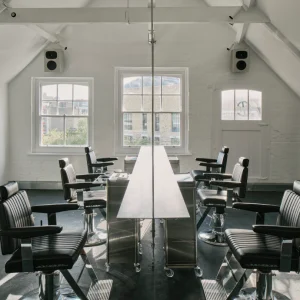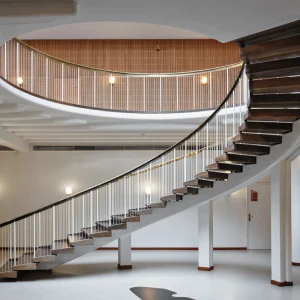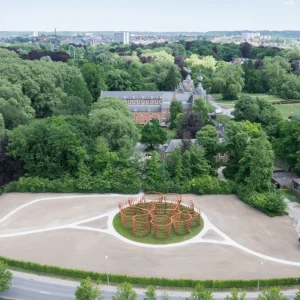Beatrix Potter, The Tale of Peter Rabbit
A reminder of childhood, and a reminder to never give up. Beatrix Potter’s letter to Nöel Moore of 4 September 1893 contains the first reference to a story concerning Flopsy, Mopsy, Cottontail and Peter. After she received her art student’s certificate in 1880 ‘for model drawing’ and first sold some of her watercolours in 1892, she wrote to Moore while on holiday in Dunkeld, four years before she published a privately printed black and white edition, and 10 years before the world got to read about a rabbit that disobeyed his mother and ran off into Mr McGregor’s vegetable garden. Rejected by six publishers, now more than two million of Potter’s books are sold every year.
Mackintosh chairs for the Luncheon Room of the Argyle Street Tea Rooms
Commissioned by Kate Cranston in 1897, these chairs were chosen for Charles Rennie Mackintosh’s own flat in Mains Street, Glasgow, designed by his wife-to-be Margaret Macdonald. For me they evoke Glasgow, and rich and happy memories of the School of Art, the Citizens Theatre, The Arches, and late breakfasts at Gandolfi’s in Albion Street.
An altarpiece depicting the Apocalypse by Master Bertram from Hamburg, c1380
Bertram von Minden worked in Hamburg, painting in various churches towards the end of the 14th century. Altarpieces with scenes from the last book of the Bible, the Revelation of St John the Divine (the Apocalypse) are rare. This panel, one of 45 held by the V&A, illustrates the beginning of chapter eight, in St John’s vision, at the moment of the opening of the seventh seal. For me, it is a genuine taste of the medieval world that I have been writing a book about for the past few years.
David Storey’s ‘Home’ at The Royal Court
The V&A does not have much in the way of Royal Shakespeare Company records (otherwise I should have chosen something from David Warner’s Hamlet of 1965, of which Harold Hobson wrote ‘he does not move or speak or drink like a prince. As a matter of fact, few princes do’) hence my choice of theatrical memorabilia of The Royal Court theatre, whose archive 1934-2007 is held by the museum.
Hidden in there are six folders of photographs of David Storey’s play Home, first performed in 1970 with John Gielgud and Ralph Richardson. The rehearsals, directed by Anthony Page, were being conducted downstairs in the main auditorium while my production of Search for a Hero was in performance ‘Upstairs’.
Gustave Le Gray’s Solar Effect in the Clouds – Ocean, 1856
Gustave Le Gray was a 19th-century French painter who took up photography in his late 20s. Technically brilliant, there is an expressive grandeur about his seascapes. In the picture that I have chosen from the collection we are forced to confront the sea and potentially threatening clouds, an interplay of sea and sky, inclement weather under steely skies on the horizon, reminding me of Victor Hugo’s Voyage en Normandie: ‘Suddenly I raised, or rather I lowered my eyes. In front of us was an immense gulf of shadow into which the sea cut whitish indentations.’
Alfred Stieglitz photograph of Georgia O’Keeffe from the Thirties
Stieglitz and O’Keeffe collaborated for more than 20 years, resulting in over 300 photographs, a lovers’ artistic dialogue that profoundly influenced them both. Here she is, like some Pueblo Indian, wrapped in a blanket under the sunlit air of Taos, before she turned her eyes from distant landscapes to the less interesting, claustrophobic close-ups of magnified flowers. She found ‘the wideness and wonder of the world as I live it’ in New Mexico, to which she returned every year for 20 years, where ‘I painted it often enough thinking that, if I did so, God would give it to me’. The largest repository of O’Keeffe’s work, with more than 3,000 pieces, is the eponymous museum in Santa Fe, New Mexico, that this year celebrates its 15th anniversary.
Dior dress – 1947 ‘New Look’ day dress
My mum had a 1947 lightweight, unlined, Christian Dior ‘New Look’ day dress. It puts me in mind of visits to Les Rhumbs’ Dior’s childhood home in Granville, a belle-epoque-style 19th-century clifftop villa overlooking the sea where they have costume exhibitions. As it is the only Musée de France dedicated to a couturier it is special, presenting haute couture garments over three floors. The garden is also very nice, arranged as a piece of English landscaping by Madeleine Dior, his mother.
This year’s exhibition at Les Rhumbs’ is a homage to the silver screen, Dior fashion worn by movie stars on the screen and in the streets – Dietrich (‘No Dior, no Dietrich!’), Liz Taylor, Bardot, Isabelle Adjani, Lauren Hutton, Penelope Cruz et al, together with sketches, film posters, clips, scripts and archives, with the costumes displayed on mannequins. Great!





